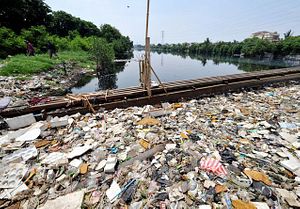Suratmo, a fisherman living on the banks of the Citarum River, could only laugh softly when asked about his catch today. He replied that he could no longer be called a fisherman. For the last five years, his income has no longer come from catching fish, but fishing used items such as glass bottles from the mountains of garbage in what is often called the world’s most polluted river. Yes, Suratmo can no longer be called a fisherman — he is now a garbage collector.
Every day, no less than 20,000 tons of waste and 340,000 tons of wastewater, mostly from 2,000 textile factories, are disposed directly into the once clear and pristine waterways of the Citarum River. No wonder the fish are largely gone in the third-biggest river in Java.
The Conditions
To illustrate how dirty the Citarum River is, at some places we cannot even see the water. Its surface is completely covered by the unimaginable amount of waste, trash, and dead animals floating on it. If we are lucky enough to glimpse the water, we will see it is colored due to the excessive amount of toxic chemicals being dumped into the river by industries. Not surprisingly, since 2008, nearly 60 percent of the river’s fish species have been destroyed.
Yet despite those very poor conditions, the Citarum River is vital for the 25 million people who daily depend on it for agriculture, water, and electricity.
As Indonesia’s most strategic river, the Citarum is the source of water for the Jatiluhur Reservoir, which is Indonesia’s largest reservoir at 3 billion cubic meters of storage capacity. The reservoir not only supplies clean water for Bandung but also provides 80 percent of the water supply for the capital. It also irrigates 400,000 hectares of rice fields and is a source of energy for three hydroelectric power stations serving three cities.
Yet a study conducted by the Blacksmith Institute in 2013 found that levels of lead in the Citarum River reached 1,000 times worse than the U.S. standards for drinking water. With severe pollution from lead, aluminum, manganese, and iron since 2002, the Citarum has never met the water quality standards of Government Regulation No. 82 of 2001 on Water Quality Management and Water Pollution Control.
Because people have been depending on this heavily polluted water, many now suffer from various skin diseases, ranging from scabies to infections, not to mention respiratory distress due to inhaling factory smoke. In addition, poor water quality due to waste and pollution also damages the crops of farmers.
Jokowi’s Promises
Over the years, successive governments have vowed to clean the Citarum, but they mainly failed because such efforts were only partially done. However, in February, after visiting the location, President Joko “Jokowi” Widodo declared a seven-year Citarum cleansing program with a final goal of making Citarum water drinkable by 2025. The program will also be supported by the International Monetary Fund (IMF) and Asian Development Bank (ADB), which in 2009 had already committed to provide $500 million to fund the Citarum’s rehabilitation.
From 1 February 1, 2018, a total of 7,100 joint personnel led by the Indonesian Army were divided into 22 sectors along this 300 km river to clear garbage from the river and to bring plant life back to the critical lands surrounding the Citarum. Citarum reforestation is critical – 2,500 hectares of sector 1 upstream land and 80,000 hectares of land adjacent to the river have been heavily affected by the rapid industrialization in the region since the 1980s.
The coordinator of the Citarum Sector 1 cleansing program, Colonel Yanto, said that it is estimated that reforestation will require 125 million trees — consisting of 25 million hardwood plants and 100 million shrubs — to be planted in the immediate vicinity of the river. The hope is that, in the next five years, Indonesia can end the floods partly caused by clogged garbage and overflowing rivers.
However, efforts to clean up the river will be a waste if the government does not immediately take action against rogue businessmen who create dumping holes containing industrial wastewater that pollute the river. The authorities should go straight to the source to seal-off dumping holes and explicitly remove business permits for those who remain ignorant of the rules.
Future Benefits
With the Citarum clean of waste and integrated industrial wastewater treatment, the World Bank has estimated that Indonesia will get a massive range of benefits. Not only will the water ecosystem return to a healthy state, but the clean Citarum will bring economic benefits of up to $280 million annually.
Clean water will improve the quality of drinking water, improve crop yields, and in the long term revitalize the ecosystem and the volume of fish in the river. And when downstream canals are not clogged with garbage, aesthetically pleasing, crystal clear river water will make riverside property more attractive and resorts and water tourism can grow and prosper.
But none of those dreams will come true if fishermen like Suratmo are only pulling garbage, rather than fish, out of the river.
Dikanaya Tarahita and Muhammad Zulfikar Rakhmat are independent researchers focusing on social issues in Indonesia. Both are the founders of Sekolabilitas, an Indonesian-based NGO dedicated to helping individuals with disabilities access education.

































